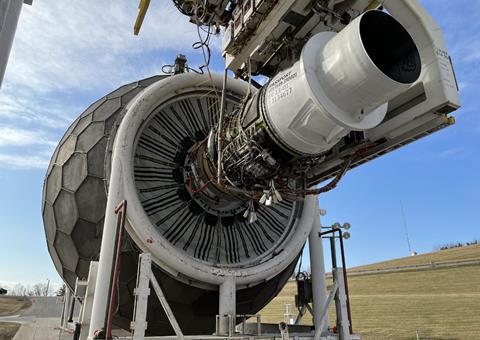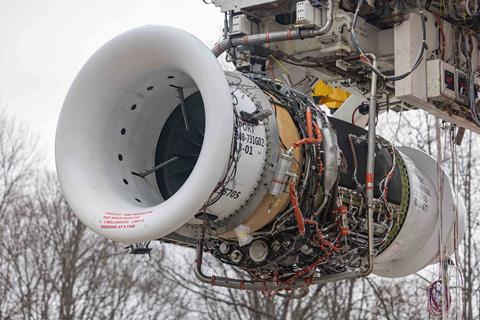GE Aerospace is to modify a Passport business jet engine with a hybrid-electric system through a NASA-led project that also supports development of the CFM International RISE open-fan demonstrator.
Ohio-based GE Aerospace will equip the Passport – a 20,000lb (86kN)-thrust turbofan that powers the Bombardier Global 7500 – with an electric motor/generators under NASA’s Turbofan Power Extraction (PEx) demonstration effort.
“GE Aerospace is developing a hybrid-electric demonstrator engine with NASA that will embed electric motor/generators in a high-bypass commercial turbofan to supplement power during different phases of operation,” the company says.

The PEx work is part of NASA’s broader Hybrid Thermally Efficient Core (HyTEC) project to demonstrate a compact engine core for future narrowbody applications. As the name suggests, hybridisation forms a core strand of that effort – to both extract greater amounts of electrical power from the engine and to augment the turbine in certain flight phases, helping to cut fuel burn.
One of HyTEC’s goals is achieve power extraction of up to 20% at altitude, anywhere between two to four times the current maximum.
HyTEC also supports GE’s work, through its CFM joint venture with Safran Aircraft Engines, on the open-fan RISE demonstrator programme. That effort, designed to deliver a 20% reduction in fuel burn over today’s top-performing powerplants, also includes hybrid-electric technology.
GE has already been developing components for the core through the first phase of the HyTEC programme, but under a Phase 2 contract awarded in December last year it will look to mature those technologies ahead of a core demonstrator test later this decade.
The Phase 2 work ”will further advance the state-of-the-art for engine integration of hybrid electric systems”, GE states.
GE’s hybridisation of the Passport will “optimise engine performance by creating a system that can work with or without energy storage like batteries.
“This could help accelerate the introduction of hybrid-electric technologies for commercial aviation prior to energy storage solutions being fully matured.”
GE has already completed “high-level testing” at its Dayton, Ohio facility of the system’s electric motor, generators and other components, and performed baseline testing of the engine at its Peebles, Ohio site ”to characterise performance before hybrid-electric components are added”.
Results from both sets of tests ”are being used to evaluate and update models in preparation for a ground test,” GE says.
In addition to the HyTEC work, GE is developing a megawatt-class hybrid-electric propulsion system under a separate NASA programme called the Electrified Powertrain Flight Demonstration. GE intends to flight test the system using a Saab 340B.



























